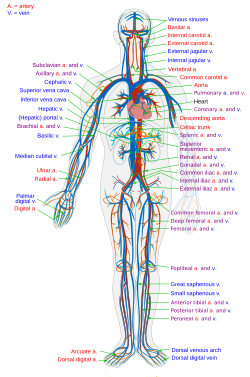
Back Bloedvat Afrikaans የደም ቧንቧ Amharic Vaso sanguinio AN وعاء دموي Arabic ৰক্তবাহিকা Assamese Qan damarları Azerbaijani قان داماری AZB Ҡан тамырҙары Bashkir Крывяносныя сасуды Byelorussian Кръвоносен съд Bulgarian
| Blood vessel | |
|---|---|
 Simple diagram of the human circulatory system | |
| Details | |
| System | Circulatory system |
| Identifiers | |
| Latin | vas sanguineum |
| MeSH | D001808 |
| TA98 | A12.0.00.001 |
| TA2 | 3895 |
| FMA | 63183 |
| Anatomical terminology | |
Blood vessels are the components of the circulatory system that transport blood throughout the human body.[1] These vessels transport blood cells, nutrients, and oxygen to the tissues of the body. They also take waste and carbon dioxide away from the tissues. Blood vessels are needed to sustain life, because all of the body's tissues rely on their functionality.[2]
There are five types of blood vessels: the arteries, which carry the blood away from the heart; the arterioles; the capillaries, where the exchange of water and chemicals between the blood and the tissues occurs; the venules; and the veins, which carry blood from the capillaries back towards the heart.
The word vascular, meaning relating to the blood vessels, is derived from the Latin vas, meaning vessel. Some structures – such as cartilage, the epithelium, and the lens and cornea of the eye – do not contain blood vessels and are labeled avascular.
- ^ Shea MJ. "Blood Vessels – Heart and Blood Vessel Disorders". Merck Manuals Consumer Version. Merck Sharp & Dohme Corp. Archived from the original on 24 April 2015. Retrieved 2016-12-22.
- ^ "How Does Blood Flow Through Your Body". Cleveland Clinic.
© MMXXIII Rich X Search. We shall prevail. All rights reserved. Rich X Search